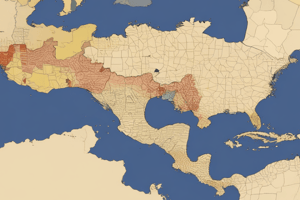Podcast
Questions and Answers
¿Cuál es el volcán más famoso de Nicaragua que tuvo su última erupción en 1835 y creó una nueva isla frente a sus costas?
¿Cuál es el volcán más famoso de Nicaragua que tuvo su última erupción en 1835 y creó una nueva isla frente a sus costas?
- Momotombo
- Cosigüina (correct)
- Mombacho
- Masaya
¿En qué lago de Nicaragua se puede encontrar una especie de tiburón de agua dulce llamado tiburón toro?
¿En qué lago de Nicaragua se puede encontrar una especie de tiburón de agua dulce llamado tiburón toro?
- Lago Xolotlán
- Lago Managua
- Lago Nicaragua (correct)
- Lago Cocibolca
¿Cuál de los siguientes volcanes en Nicaragua tuvo actividad reciente en 2015 dejando una impresionante corriente de lava visible desde León?
¿Cuál de los siguientes volcanes en Nicaragua tuvo actividad reciente en 2015 dejando una impresionante corriente de lava visible desde León?
- San Cristóbal
- Momotombo (correct)
- Maderas
- Concepción
¿Dónde se localiza el archipiélago de Solentiname, un grupo de islas que ofrecen un escape tranquilo de la ajetreada vida en tierra firme?
¿Dónde se localiza el archipiélago de Solentiname, un grupo de islas que ofrecen un escape tranquilo de la ajetreada vida en tierra firme?
¿En qué región geográfica se destaca Nicaragua por tener 19 volcanes activos y dormidos?
¿En qué región geográfica se destaca Nicaragua por tener 19 volcanes activos y dormidos?
¿Cuál es el punto más alto de Nicaragua ubicado en la Cordillera Dariense?
¿Cuál es el punto más alto de Nicaragua ubicado en la Cordillera Dariense?
¿Qué caracteriza al clima de la costa del Pacífico en Nicaragua?
¿Qué caracteriza al clima de la costa del Pacífico en Nicaragua?
¿Cuál es el río más famoso de Nicaragua que también forma parte de la frontera con Costa Rica?
¿Cuál es el río más famoso de Nicaragua que también forma parte de la frontera con Costa Rica?
¿Qué tipo de clima se experimenta generalmente en las tierras altas de Nicaragua a lo largo de la cordillera?
¿Qué tipo de clima se experimenta generalmente en las tierras altas de Nicaragua a lo largo de la cordillera?
¿Cuál es el río más grande de América Central que fluye desde Nicaragua hacia Honduras?
¿Cuál es el río más grande de América Central que fluye desde Nicaragua hacia Honduras?
Flashcards are hidden until you start studying
Study Notes
Geographical Wonders of Nicaragua
Nestled between Honduras to the north and Costa Rica to the south, Nicaragua's vast landscape boasts a diverse array of natural phenomena. From towering volcanoes to pristine lakes, serpentine mountain ranges, and rivers that carve through the heart of the country, Nicaragua's geography is a testament to the power of nature.
Volcanoes
Nicaragua is home to a whopping 19 active and dormant volcanoes, making it one of the world's most volcanically active regions. The most famous of these is Cosigüina, a symmetrical stratovolcano located on the Pacific coast. Its last eruption took place in 1835, creating a new island off its shores. Momotombo, another volcano, is also situated on the Pacific coast and was last active in 2015, leaving a stunning lava flow visible from the nearby town of León.
Lakes
With an abundance of craters left by volcanic activity, Nicaragua is graced with a stunning collection of lakes. Lake Nicaragua is the largest lake in Central America and the 19th largest in the world. It's also the only freshwater lake with a shark species, the Bull shark, inhabiting its waters. Lake Managua is another notable lake, serving as the capital city's namesake. The most picturesque lake, however, might be Cocibolca, which is home to the archipelago of Solentiname, a series of islands that offer a peaceful escape from the bustle of the mainland.
Mountain Ranges
The Cordillera Dariense, Cordillera Isabelia, and Cordillera Los Maribios are the prominent mountain ranges that cross Nicaragua, offering a variety of topographic features. The Cordillera Dariense, for instance, is home to the highest point in the country, Mogotón, standing at 2,447 meters (7,996 feet). The Cordillera Isabelia, on the other hand, is a popular destination for hikers and nature enthusiasts, boasting lush forests and diverse wildlife.
Climate
Nicaragua's diverse landscape and unique geography contribute to a varied climate. The Pacific side of the country is characterized by a hot, dry climate, while the Atlantic side is more tropical and humid. The highlands, along the continental divide, are generally cooler and wetter, while the lowlands enjoy a more moderate climate.
Rivers
The Río San Juan is the most famous river in Nicaragua, cutting through the country's center and forming the border with Costa Rica. This river is considered a natural wonder due to the unique flora and fauna that thrive along its banks. Another notable river is the Río Coco, which flows from Nicaragua into Honduras and is the largest river in Central America. The Río Escondido and Río Guasaule are also significant rivers that contribute to the biodiversity of the country.
Nicaragua's stunning geographical features are not only a sight to behold but also a source of immense ecological and cultural significance. Whether you're an adventurer seeking to explore volcanoes, a nature enthusiast looking to discover new flora and fauna, or simply someone in search of a peaceful getaway, Nicaragua's wonders have something to offer everyone.
Studying That Suits You
Use AI to generate personalized quizzes and flashcards to suit your learning preferences.




